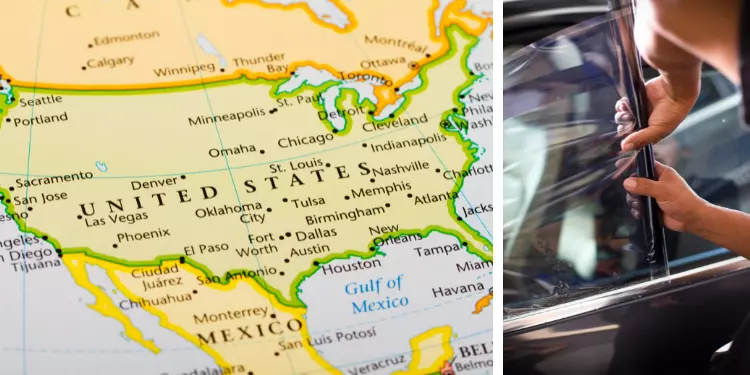Table of Contents
When it comes to window tinting, car owners often wonder, “Is window tinting legal?” The answer is, yes, window tinting is legal as long as you adhere to the laws and regulations set forth by your specific state. However, it’s essential to recognize that these laws can vary significantly from one state to another. In this comprehensive guide, we will delve into the intricacies of window tinting regulations and help you understand how to comply with the legal requirements in your state.
1 The Purpose and Benefits of Window Tinting
Window tinting refers to the thin film applied to a vehicle’s front, side, and rear windows to reduce the amount of light that penetrates the security glass. Apart from enhancing the vehicle’s aesthetic appeal, window tinting also serves practical purposes. It provides protection against harmful UV-A and UV-B rays, known to be contributing factors in certain skin diseases. Car manufacturers often install window tints during the production process, adhering to the laws and guidelines of the state where the vehicle is primarily manufactured.
2 Understanding Window Tinting Laws
While some vehicles come with factory-installed window tints that comply with state laws, others may require additional tinting services from private companies or car owners themselves. This is where window tinting rules can sometimes be inadvertently violated. Each state has specific regulations concerning the darkness or “light transmittance” of window tints, which directly affects the visibility from inside and outside the vehicle.
The reasons for limiting the darkness of window tints are multifaceted. One crucial aspect is to ensure public safety and law enforcement. Excessively dark window tints can obstruct visibility, making it difficult for drivers to see the road properly. Additionally, law enforcement officers need to be able to see inside a vehicle for security purposes, ensuring that no illegal activities are taking place.
3 Window Tinting Rules Across the United States
The United States allows car window tinting, but the permissible degree varies from state to state. Each state specifies the “legal percentage of window tint” that is allowed. For instance, let’s take a look at North Carolina’s regulations. According to their rules, the window tint must be no more than 5 inches high in the front window or in the AS1 line, whichever is longer, and should permit at least 35% light transmission. On the other hand, Tennessee prohibits the use of window tint that allows less than 35% light transmission in the windshield.
It’s essential to familiarize yourself with your specific state’s window tinting laws to ensure compliance. If you live in multiple states or frequently travel between states, be aware that what’s permissible in one state might be illegal in another.
4 Legal Window Tint Percentage By State
To provide you with a clearer understanding of the varying window tinting regulations, here’s a comprehensive chart presenting the legal window tint percentages by state for front side windows, back side windows, rear windows, and windshields:

5 Special Considerations: Limo Tints and Eyebrow Tints
Apart from standard vehicle window tinting, there are specific considerations for limo tints and eyebrow tints. Limo tints, which are very dark tints often associated with privacy, are subject to individual state regulations defined by the Department of Motor Vehicles. For example, California allows up to 70% visible light transmission on front passenger windows, making limo tints illegal in this case.
Eyebrow tints, referring to small strips of tint on the vehicle’s windshield, are usually allowed if they comply with the state’s laws. However, it’s crucial to research the laws of your state before installation, as some states may prohibit their use.
6 Consequences of Non-Compliance with Window Tint Rules
It’s crucial to comply with state window tinting regulations to avoid legal complications. Vehicles with window tints that permit less light transmission than what is legally allowed are at risk of being pulled over and subjected to a police investigation. In such instances, a citation is typically issued, resulting in fines or other penalties.
7 Exceptions for Medical Conditions
In some cases, exceptions to window tinting regulations are made for individuals with medical conditions that require extra sensitivity to light. Conditions like albinism or certain skin conditions may necessitate additional protection from harmful UV rays. If you have a medical condition that warrants an exception, it’s essential to obtain a prescription from your doctor and keep it in the car for law enforcement purposes.
8 Conclusion: Safe and Compliant Window Tinting
In conclusion, window tinting is a valuable addition to any vehicle, offering protection from harmful sun rays and enhancing its overall appearance. However, it’s essential to recognize that each state has its specific tint percentage laws, and it’s crucial to abide by these regulations for your safety and the safety of others on the road.
Before tinting your car windows, thoroughly research the laws and guidelines applicable to your state. Consult reputable tinting associations to help you choose the appropriate tint percentage that aligns with your state’s regulations. By doing so, you can enjoy the benefits of window tinting while remaining compliant with the law.
Remember, window tinting laws exist to ensure public safety, so let’s respect these rules and drive responsibly with our tinted windows.
Disclaimer: This article is for informational purposes only. It does not constitute professional advice. Always consult a qualified expert for specific guidance related to your individual circumstances.














